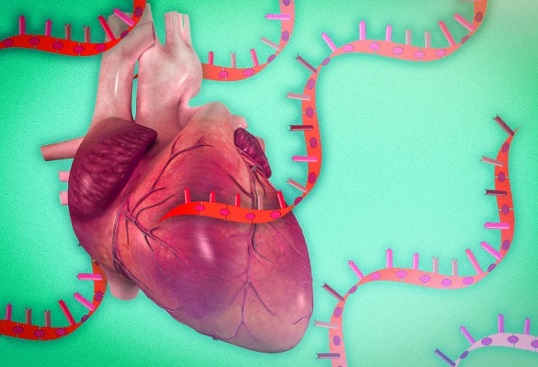Viral RNA from COVID-19 Virus Found to Directly Sabotage the Heart by Mimicking Genetic Mechanisms
Nikhil Prasad Fact checked by:Thailand Medical News Team Jun 06, 2025 7 months, 2 days, 8 hours, 37 minutes ago
Medical News: Shocking Discovery Shows SARSCoV2 RNA Fragment Can Trigger Heart Cell Damage Like a Gene Silencing Weapon
A groundbreaking new study by researchers in Japan has revealed a chilling mechanism by which SARS-CoV-2, the virus that causes COVID-19, can directly damage the human heart. Scientists have discovered that a small fragment of RNA from the virus acts like a stealthy gene-silencing weapon, hijacking a critical function inside heart cells and triggering dysfunction that could contribute to heart failure, even without direct viral infection.
 Viral RNA from COVID-19 Virus Found to Directly Sabotage the Heart by Mimicking Genetic Mechanisms
Viral RNA from COVID-19 Virus Found to Directly Sabotage the Heart by Mimicking Genetic Mechanisms
This
Medical News report unpacks the details of this stunning discovery, which could explain why so many COVID-19 patients—even those with mild cases—suffer long-term cardiovascular complications.
The study was conducted by a team of researchers from the Department of Molecular Pathology at Nara Medical University School of Medicine, the Division of Rehabilitation at Hanna Central Hospital, the Department of Medical Ethics and Genetics at Kyoto University, the Institute of Biomedical Science at Kansai Medical University, and Nozaki Tokushukai Hospital.
A 19-Nucleotide Saboteur
At the heart of the study is a 19-nucleotide RNA fragment found within the SARS-CoV-2 genome. This tiny strand matches a section of the human ATP5A gene—an essential gene involved in producing energy in heart cells—almost perfectly. The ATP5A gene encodes a subunit of ATP synthase, the enzyme that generates cellular energy in mitochondria.
The researchers found that the viral RNA fragment mimics a natural small interfering RNA (siRNA). This mimicry tricks the heart cells into silencing their own ATP5A gene, disrupting mitochondrial energy production, and impairing the cell's ability to function and mature properly.
When the researchers introduced this viral RNA into human heart cells, they observed a cascade of damage: a sharp drop in ATP levels, mitochondrial dysfunction, and increased oxidative stress—all of which are linked to heart failure.
Hijacking the Body’s RNA Machinery
Further investigation showed that the antisense strand of this RNA fragment bound to Argonaute 2 (AGO2), a protein central to the RNA-induced silencing complex (RISC). This is the same cellular machinery used by natural siRNAs to regulate genes. Once loaded into RISC, the viral RNA was able to silence the ATP5A gene efficiently.
To simulate how this viral fragment might be delivered in real infections, the team packaged the RNA into exosome-like liposomes—tiny vesicles that mimic the way cells naturally exchange molecules. When these were introduced to heart cells, they dramatically amplified the RNA's gene-silencing effects—up to 2,000 times stronger than when the RNA was delivered alone.
Energy Crisis
in Heart Cells
Mitochondrial analysis revealed that cells treated with the viral RNA experienced massive disruptions in energy metabolism. The oxygen consumption rate dropped, ATP production fell, and proton leakage across mitochondrial membranes increased—classic signs of failing mitochondria.
The cells attempted to compensate by increasing glycolysis, but it wasn't enough. The energy shortage led to stress responses, accumulation of damaging molecules like 4-hydroxynonenal, and cell death through apoptosis.
Stunted Maturation and Signs of Heart Failure
The researchers also found that heart cells exposed to the viral RNA showed signs of arrested development. Key maturation proteins like troponin T and myosin light chain were suppressed, while immature forms like MYH7 increased. Calcium levels rose abnormally, atrial natriuretic peptide (a heart stress marker) surged 50-fold, and the expression of protective sirtuin 6 dropped.
Together, these changes mimic a pattern seen in heart failure: immature, energy-starved heart cells struggling to maintain normal function.
Not a Fluke of Evolution
The researchers emphasized that this was not the result of viral evolution intentionally targeting human genes. Instead, it appears to be a rare, coincidental match—yet one with devastating effects. Other strains of SARS-CoV-2, like the Japanese and LA variants, share this exact fragment, while others like the Wuhan and WA variants show minor mismatches that reduce the gene-silencing impact.
Implications for Long COVID and Cardiac Injury
The findings provide a possible explanation for the cardiac complications observed in COVID-19 and Long COVID patients—even those who never experienced severe infection. Since this viral RNA doesn’t require direct viral invasion of heart tissue, it could be traveling via exosomes or free-floating in blood, affecting distant organs.
The researchers urge further studies in animal models and patient samples to confirm how frequently this mechanism occurs in real-life infections and whether it contributes to the long-term heart damage seen in many COVID-19 survivors.
Conclusion
This study uncovers a disturbing mechanism by which a small fragment of SARS-CoV-2 RNA can mimic human gene regulators and shut down vital energy processes in heart cells. By silencing the ATP5A gene through siRNA-like activity, the viral fragment triggers mitochondrial dysfunction, impairs heart cell development, and promotes features resembling heart failure. These insights could reshape our understanding of how COVID-19 affects the heart and raise important questions about the long-term impact of even asymptomatic or mild infections.
The study findings were published in the peer reviewed International Journal of Molecular Sciences
https://www.mdpi.com/1422-0067/26/11/5392
For the latest COVID-19 News, keep on logging to Thailand
Medical News.
Read Also:
https://www.thailandmedical.news/news/silent-rise-in-at-home-cardiac-deaths-since-covid19-pandemic-sparks-new-concerns
https://www.thailandmedical.news/news/sars-cov-2-destroys-heart-cell-mitochondria-leading-to-dangerous-long-covid-cardiac-issues
https://www.thailandmedical.news/news/deadly-drug-combo-involving-covid-19-antiviral-and-blood-pressure-med-found-to-trigger-complete-heart-block
https://www.thailandmedical.news/articles/coronavirus
https://www.thailandmedical.news/pages/thailand_doctors_listings
